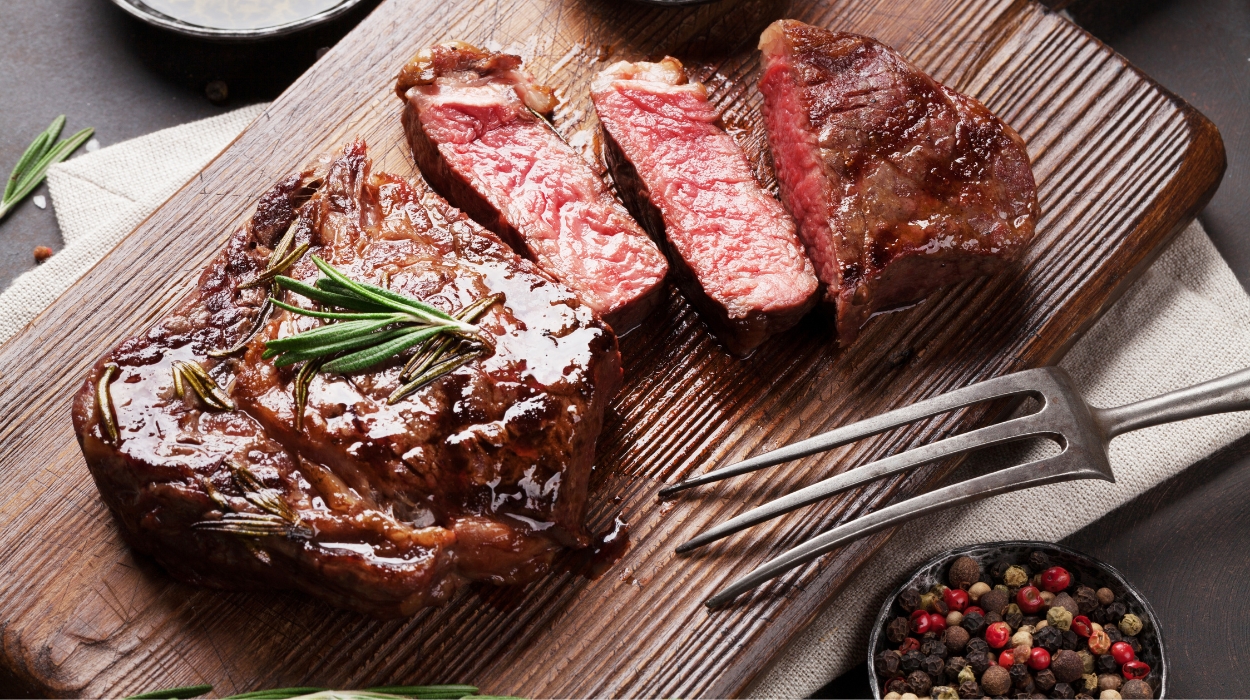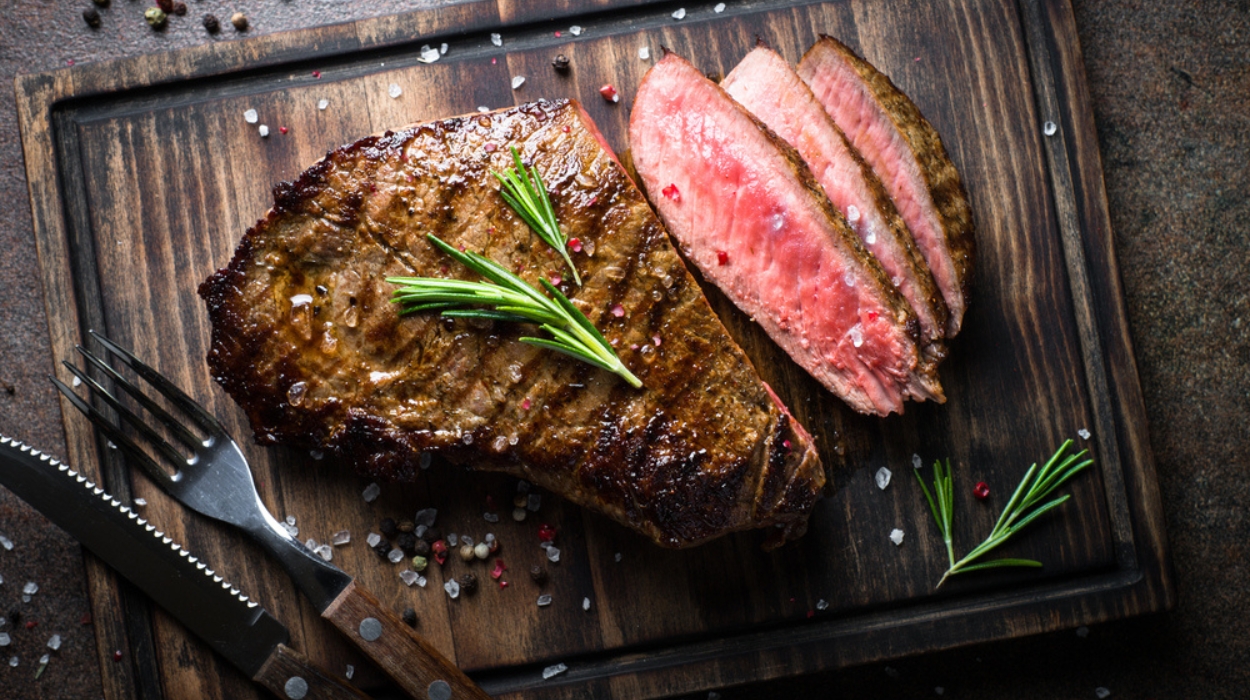If you’re looking to lose weight but enjoy eating steak, you’ve found the right article! When it comes to losing weight, you might think you need to avoid certain foods, like red meat. But what if we told you that a juicy steak could be part of a healthy weight-loss diet?
It may come as a surprise, but steak may actually support weight loss efforts. In this article, we’ll explore and answer the question: is steak good for weight loss?
From its nutrient density to its ability to keep you satiated, we will explore how steak can support weight loss. We’ll also offer some ideas on how to incorporate red meat into your diet and tips on what to avoid when preparing steak.
If you’re looking for some extra support, it might be a good idea to check out the various fat burners on the market.
Is Steak Good For Weight Loss?
- Yes, steak can be a valuable part of a weight loss plan when chosen and prepared carefully.
- Opting for lean cuts, like sirloin, or trimming visible fats, helps reduce calorie intake.
- Steak is a rich source of protein, promoting satiety and muscle development.
- It delivers essential nutrients, such as iron and B vitamins.
- Moderation is key, as excessive consumption may lead to a higher saturated fat intake.
- Balancing steak with a variety of nutrient-dense foods and mindful portion control ensures a delicious and supportive addition to a healthy diet.
Is Steak Good For Weight Loss?

Steak can most definitely be part of a balanced diet, and here’s why:
High Protein Content
Steak is a good source of protein, which is key for muscle growth and repair. Protein is also known for keeping you fuller for longer,[1] which means you’re less likely to snack on unhealthy foods.
Increased Satiety
Steak is rich in protein and fat, which work together to help digestion[2] and keep satisfied for longer periods. The combination of protein, fat, and carbohydrates makes you empty your stomach faster, which decreases ghrelin, the hormone that increases appetite. Steak could be a great option if you’re looking to cut your excess snacking down. By reducing overall calorie intake, steak can help you shed those pounds without sacrificing taste or satisfaction.
Low In Calories
Indulging in a delicious steak doesn’t have to derail your weight loss goals. Opting for leaner cuts allows you to relish steaks’ rich flavors without a calorie overload. You can also trim off any visible fat on your steak to not only create a leaner and healthier option but to ensure fewer calories.
Starting your weight loss journey doesn’t mean you have to say goodbye to steak. It’s all about making smart choices, starting with the cut. Each steak variety offers a unique balance of flavors, textures, and nutrients. Let’s take a look at some good options to help you lose weight.
Ribeye Steak
Indulging in a ribeye steak doesn’t have to be a guilty pleasure. Ribeye is known for its delicious flavor. Opt for a leaner cut or trim visible fats to make it good for weight loss. Healthy cooking methods, such as grilling, allow excess fats to drip away. This allows you to relish the intense flavors of the ribeye without impacting weight loss goals.
Sirloin Steak
Sirloin steak is another lean beef option, offering a balance between flavor and leanness. Lower in excess fats, sirloin provides a protein-packed, low-calorie option that keeps you fuller for longer. It can also be prepared in a variety of ways, including grilling and pan-searing, making it a versatile choice.
T-Bone Steak
T-bone steak has a combination of tenderloin and New York strip, offering a delicious flavor and texture. To make it a healthier option, focus on portion control and mindful preparation. Trim any visible fat and opt for healthier cooking methods, such as grilling, to reduce its fat content.
The Nutritional Value Of Steak
Steak is not just high in protein, but it also contains a range of micronutrients that are essential for a healthy diet. Here’s a breakdown of the nutritional value of a 3-ounce serving of steak:[3]
- Protein: 23 grams.
- Fat: 9.7 grams, including 4 grams of saturated fat.
- Carbohydrates: 0 grams.
- Calories: 180.
- Iron: 38% of the daily recommended intake.[4]
- Zinc: 36% of the daily recommended intake.
- Vitamin B12: 67% of the daily recommended intake.
Steak is a great source of protein, delivering the amino acids necessary for muscle growth and repair.[5] Beyond this, steak also has significant amounts of iron and zinc. These essential minerals are vital for keeping energy levels up[6] and supporting immune function.[7]
Steak is a B-vitamin powerhouse containing key B vitamins, including vitamin B12. Vitamin B12 is essential for supporting nerve function[8] and brain function.[9]
It’s important to be mindful of its fat content, particularly saturated fat. Opting for lean cuts, trimming any visible fat, and being mindful of portion sizes are all good options for managing your fat intake.
Tips For Eating

As with any balanced diet, try and stick to a standard serving size. For steak, this is about 3 ounces, similar to a deck of cards. It’s easy to go overboard with steak, but this can quite quickly pile on excess calories.
As we’ve discussed previously, try and opt for leaner cuts as they tend to be lower in saturated fat and calories. You can ensure your steak is even leaner by trimming any visible fat before cooking.
Also, remember to be mindful of your cooking method. Grilling is a great option for weight loss, as it allows any excess fat to drip away and doesn’t require any additional fat to be added. However, on a different subject altogether, grilled fats that drip can create carcinogens[10] in the lean meat, further supporting portion control.
Try and avoid adding extra butter, oil, or cream sauces to your steak, as these can negatively affect weight loss efforts. Elevate your steak dish by pairing it with fiber-rich sides, such as roasted vegetables or a colorful salad. The added fiber will help you feel fuller for longer,[11] curbing the temptation for unnecessary snacking.
Here are some recipe ideas to get you started.
- Grilled Lemon Herb Sirloin Steak Skewers: Marinate bite-sized steak cubes in a zesty blend of lemon, garlic, and assorted herbs. Thread them onto skewers and grill until cooked to your liking.
- Balsamic Glazed Ribeye Steak Bowl: Elevate your salad game by featuring slices of trimmed ribeye drizzled with a tangy balsamic glaze. Combine with a vibrant mix of leafy greens, cherry tomatoes, and cucumber for a satisfying and nutritious meal.
- T-Bone Stir-Fry with Colorful Veggies: Slice the T-Bone into thin strips and stir-fry with broccoli, bell peppers, and snap peas in a light, savory sauce.
Conclusion
When approached mindfully, steak can indeed be a valuable ally to your weight loss journey. Choosing the right cut, such as sirloin or ribeye, offers the health benefits of steak without negatively impacting your weight loss journey.
The key also lies in moderation and smart choices. Trim visible fats, stick to standard serving sizes, and opt for low-calorie sauces/marinades when preparing your steak. Ultimately, weight loss can be accomplished through a healthy diet combined with moderation, good hydration, and ample fiber.
The joy of savoring a juicy steak need not be sacrificed for losing weight. Instead, it can be a delicious and nutritious part of your diet.
Frequently Asked Questions
While steak can be a nutritious component of a balanced diet, it’s crucial to remember that targeting specific areas for fat loss is not achievable through food alone. Overall calorie management, a balanced diet, and regular exercise can support this.
Lean meats, such as chicken breast, turkey, and fish, are great choices for weight loss. They are rich in protein, low in saturated fats, and support a healthy diet when paired with vegetables and whole grains.
Moderation is key. A serving of lean steak, about 3 ounces, provides enough protein and nutrients for weight loss. Balance it with a variety of foods and consider your overall calorie and fat intake.
Yes, when chosen lean and in moderation, beef can be part of a weight loss diet. Opt for lean cuts, control portions, and pair with plenty of vegetables and whole grains for a balanced approach.
 Evidence Based
Evidence Based